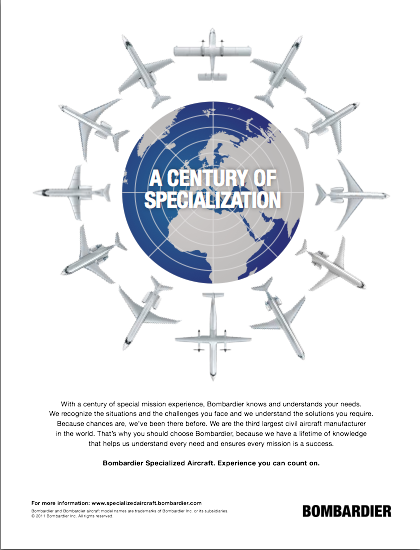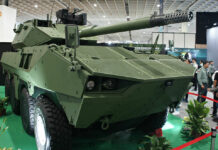
Demonstrating its commitment to the Asia-Pacific marketplace, Bombardier Aerospace showcases its comprehensive range of products at the 2012 Singapore Airshow.
Canadian manufacturer Bombardier Aerospace has more than 100 years of experience in aircraft manufacturing – its facility in Belfast, Northern Ireland for example, is one of the oldest aircraft manufacturing facilities in the world. This experience has been put to use across a wide range of different uses in the military, governmental, commercial and business aviation fields, and Bombardier aircraft have accumulated millions of flight hours.

The diversity of the different original entities that are part of Bombardier’s heritage, such as Canadair, Short Brothers, Learjet and de Havilland, gives the Company a unique blend of aerospace experience.
This combination produces an enviable track record with respect to special mission aircraft. Together, these entities have de- signed, built and delivered more than 300 special mission aircraft for customers worldwide, dating back to the early 1900s when the Royal Aero Club offered the Admiralty the use of two Gnome-engined Short Brothers aircraft (S.28 & S.29) with free tuition.
Bombardier has built on this track record and now offers an extensive range of aircraft with special mission capabilities designed to cater to a variety of requirements. Each of Bombardier’s business jets and regional aircraft are firmly established in service with specialized mission operators, putting the aircraft in a diverse range of uses.
Bombardier Aerospace has also a long history in the field of commercial turboprop production, especially when factoring in its ancestry. Bombardier currently markets the Q400 NextGen turboprop, which stands apart as a fast, quiet and fuel-efficient aircraft.
In the regional jet sector, Bombardier’s CRJ Series aircraft is the most successful commercial regional jet program in history. Bombardier also continues to innovate with the introduction of the CSeries mainline aircraft, the new benchmark in the 100- to 149-seat class, offering advanced technology, a reduced environmental impact and unsurpassed economics. The CSeries aircraft program is scheduled to enter into service in 2013, and Korean Air will be the Asian launch customer.
Bombardier also markets and supports a wide range of business jets. The Learjet aircraft, a legendary family of aircraft in business aviation that consistently shapes the way the world flies; the Challenger aircraft, with its proven dependability, over more than twenty-five years since it first soared into service, and the Global jets, extraordinary long and ultra long-range business aircraft with advanced technologies and an uncommon elegance and synergy.
The Bombardier 415 aircraft, a purpose-designed amphibious fire fighting aircraft, has proven invaluable in maritime missions such as search and rescue, coastal patrol and utility transport.
More than 35 governments worldwide are using variants of Bombardier’s business and commercial and amphibious aircraft in such missions as C4ISR, coastal patrol, search and rescue and government officials’ transport.
The Royal Air Force (RAF) Sentinel and United States Air Force Global 6000 aircraft (previously known as Global Express XRS) E11 fleets are two examples of recent programs which have made use of Bombardier’s expertise in special mission aircraft. In addition, the Hong Kong Government Flying Service (GFS) recently placed an order for two Challenger 605 aircraft to be used primarily in search and rescue, as well as other special mission applications. With the future in mind, Bombardier is continuing with the research and development of a variety of special mission applications.
This is down to technological innovation, Bombardier says. The company has a long history of fielding new, disruptive technology solutions and products by focusing on the continuing advancement of core technologies and by participating in major demonstration projects.
Core technologies include aerodynamics, materials, structures, flight sciences and electromagnetics. Examples of recent and ongoing major demonstration projects include the development of automatic fibre placement for composite fuselages; the “more electric aircraft” project; and environmental research – an increasingly important field. These projects have often involved collaboration with research and development agencies, universities and other industries.
Bombardier is already generating results – The 2008 demonstration of an all-electrical braking system was a civilian aviation world first. Other examples are the soon-to-be fielded “Equivalent Visual Operations” system, which fuses the Enhanced Vision System, Synthetic Vision System, advanced radar and other navi- gation and collision alerting systems; advanced electrical ice pro- tection; and a significant reduction of carbon dioxide and nitrous oxide.
Reducing greenhouse gas emissions of its products and facilities is also one of Bombardier’s main focuses and the Company is working hard through its research programs to significantly reduce carbon and noise footprints. Current collaborative projects involve the Consortium for Research & Innovation in Aerospace in Quebec (CRIAQ); Green Aviation Research & Development Program (GARDp); Smart Affordable Green Efficient Technology Demonstrators (SAGE); and Future Major Platforms (FMP).
Part of the drive behind these programs is that, while much of the pressure to reduce emissions is currently aimed at the commercial and business aviation sphere, in the not-so-distant future, government and military operators too will have to modify their practices.
The Future
Throughout its long history, Bombardier has been responsible for a long list of technological innovations, and this tradi- tion continues today. Emerging platforms, such as the Learjet 85 aircraft, the world’s first, primarily composite business jet; the CSeries aircraft, which will include various cutting edge technologies, and the new Global 7000 and Global 8000 busi- ness aircraft are evidence of Bombardier’s commitment to pushing the boundaries of technology in the aerospace industry.
These new aircraft programs and technological advancements, combined with Bombardier’s existing product portfolio, will ensure that the Company continues to prove attractive for business, commercial and specialized government operators around the world.





















